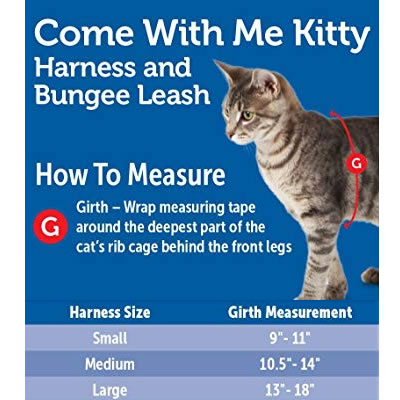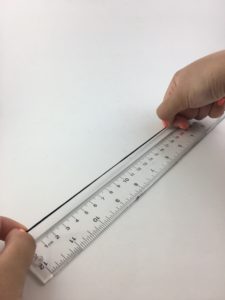How do I choose the right harness for my cat?
Note: You can click on any image in the article below to see the actual product on Amazon.com.
Before you can begin walking your cat on leash or taking your cat on outdoor adventures, you'll likely need to have your cat wear a cat harness.
Cat harnesses are often described in terms of three styles: the H-style, vests, and jackets.
However, because harnesses don't fall neatly into those three categories and product names are not consistent, those style names aren't the most helpful.
Cat harnesses can be better differentiated by two things: how they look and how they're secured around your cat's body.
How cat harnesses look
Straps: The basic cat harness is made of straps that fit around your cat's neck and chest. They're often referred to as the H-style harness.

Vests: Harnesses in the vest style generally build on the strap or H-style harness by adding material in the chest to secure your cat in the harness.

The vest style may also replace the top straps with material.

Or even go as far as replacing all the straps where the vest now looks more like a jacket.

Jackets: The jacket style generally has no straps. Material wraps your cat from the top and is secured underneath the neck and chest.

Unfortunately many products describe this as a vest. This isn't a big deal until we look at how differently vests and jackets are secured around your cat.
How cat harnesses are secured
Over the head harnesses: Generally the H-style harness has to first be slid over your cat's head and then buckled around the waist. Some cats don't like this while others have no problem. This could be a challenge when first getting your cat to wear a harness.
Note that this isn't just for strap harnesses because some vest harnesses are functionally just enhanced H-style harnesses.
Step in harnesses: More often found on dog harnesses, these harnesses are put on by first sliding the harness over your cat's legs then fastening it.
While you can take the approach of forcing your cat's paws into the harness, you might meet less resistance by placing the harness on the floor, having your cat stand with its front paws in it, then sliding the harness up and attaching it.
Over the back harnesses: Most true jacket harnesses are draped over your cat's back then secured underneath the neck and chest. This is also true of some strap style harnesses as well where the neck is not fixed but has a buckle of some sort.
This type of harness can be put on while your cat is standing up or lying down. When lying down, you'll have to lift your cat to slide the rest of the harness underneath your cat then fasten it.
What size to get
Many harnesses come in different sizes for different size cats. Each brand size will be unique to that brand. Look for a chart or recommendation with the product. Size may be based on your cat's weight or your cat's measurements around the neck and/or chest (commonly called girth).
Below are two examples.
H-style strap harness

Kitty Harness and Bungee Leash
The above strap style harness comes in small, medium, or large along with a leash.
Measure the girth on your cat to get the right size (around the body just behind the front legs) then use the chart to determine appropriate harness size.

If you don't have a flexible tape measure then you can measure the girth by taking a piece of string or something similar and wrapping it around your cat's girth. Pinch the string where it meets with your fingers then measure the length up to the pinched point with whatever measuring device you have (i.e., ruler, yardstick, etc.).

Jacket or vest style harness
Jacket and vest style harnesses are more encompassing in their fit and often more escape proof. The sizes are often based not only on girth size but also neck size.
You can find the right size Kitty Holster for your cat demonstrated in the video below.
Here's how the Kitty Holster jacket harness is put on.
Other Considerations
Comfort
A cat harness should not restrict the movement of your cat. This most often happens if it's too high up on the neck or digs between the leg and the chest. It also shouldn't make it hard for your cat to swallow or breath.
These things might happen with a poorly designed harness or a harness that's the wrong fit for your cat. Read the reviews to see if this might be a possibility for the harness you're looking to buy. Sometimes the sizing chart for the product isn't accurate and you just need to adjust for that.
Another comfort factor may have to do with skin irritation. That could come for chafing or a reaction to the material. Your cat's fur will most likely mitigate this. If your cat is hairless (either a hairless breed or shaved) then this would be more of a consideration.
Escape
A lot of harnesses advertise that they're escape proof. However, no harness is 100% escape proof. While some of those products are difficult to escape from, some of them are only trying to sell you on it. It's hard to tell which is which. Again, check the reviews for any bad experiences customers had.
A difficult to escape harness should not allow your cat to pull its leg out of the harness. This means the harness should be secure close to your cat's elbow (joint at the top of the leg). If your cat can get the elbow out then the rest of the leg will follow. All that's left is the neck after that point.
You also need to do your part as well. There are two things you can do to reduce the chance of your cat escaping.
1. Make sure the harness is put on correctly and adjusted properly. You may have to strike a balance between comfort and security.
2. Don't give your cat anything to pull against. Cats escape by backing out of the harness. That requires a tension being applied such as a leash pulling against it. Don't give your cat that tension. The automatic response may be to pull the leash when your cat tries to get away but that may just be helping your cat in its effort (it's like helping someone pull their shirt off). Learn to release the tension when your cat is backing up by walking toward your cat or to the side of your cat.
One of the most secure harnesses is the Kitty Holster above. Not only does it wrap your cat's body completely but it also doesn't require you to adjust any straps. If you don't think your cat will like the way the Kitty Holster wears then the other harnesses on this page will do a better than average job.